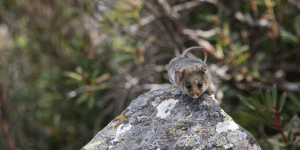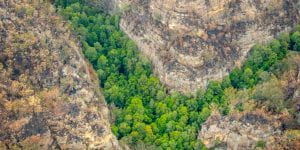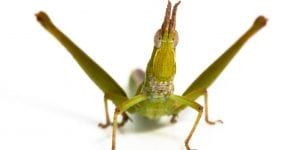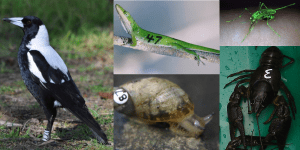Tag: threatened species conservation
-
A brief word from Ary Hoffmann on genetic rescue in Eastern Barred Bandicoots
Further details herehere -
Mini-beast renaturing: A time for local action
This article was first published on Pursuit. Read the original article. Dr Michael Magrath, Dr Steve Sinclair, Hiromi Yagui, Professor Ary Hoffmann and Professor Michael Kearney Insects in our environment are unsung heroes. These ‘mini-beasts’ are often inconspicuous, but they may have a huge impact on the health of ecosystems that sustain humanity. They pollinate […]blogs.unimelb.edu.au/pearg/2021/11/08/mini-beast-renaturing-a-time-for-local-action
-
Variety is the spice of life… and key to saving wildlife
“This article was first published on Pursuit. Read the original article.” Dr Andrew Weeks and Professor Ary Hoffmann In the critical battle against extinction, conservationists use a variety of tactics to try to save species. One of the most fundamental tools is maintaining the amount of variation of genetic material (DNA) in a group of […]blogs.unimelb.edu.au/pearg/2021/06/10/variety-is-the-spice-of-life-and-key-to-saving-wildlife
-
Male fertility ‘precariously close’ to climate change extinction limits
The loss of fertility in males as a result of climate change, particularly in the tropics, may be a better predictor of vulnerability to extinction by Dr Belinda van Heerwaarden This article was first published on Pursuit. Read the original article As temperatures rise across the globe, species will increasingly face environmental conditions beyond their […] -
The grasshopper that was lost, then found, is now endangered
This article was first published on Pursuit. Read the original article. By Professor Ary Hoffmann, Vanessa White and Professor Michael Kearney The Key’s Matchstick Grasshopper, or the Keyacris scurra, was once widespread and abundant in New South Wales, the Australian Capital Territory and north-central Victoria, but over the past century its numbers have seriously declined. […]blogs.unimelb.edu.au/pearg/2020/08/21/the-grasshopper-that-was-lost-then-found-is-now-endangered
-
Moshe Jasper: Humans of BioSciences
Meet Moshe Jasper, Research Assistant in PEARG. Moshe shares what inspired him to become a scientist and what he wishes he had known when he was an undergraduate student. What is it like to work in PEARG ? The Pest & Environmental Adaptation Research Group undertakes research on adaptation of organisms (particularly invertebrates) to environmental […]blogs.unimelb.edu.au/pearg/2020/04/24/moshe-jasper-humans-of-biosciences
-
What can cattle teach us about evolution?
Ary Hoffmann Charles Darwin in his On the Origin of Species used data from domestic animals to argue for the power of natural selection in changing phenotypes. These included examples from birds and dogs as well as livestock. The latter having been selected across many years to increase productive yields such as milk and meat. […]blogs.unimelb.edu.au/pearg/2020/04/17/what-can-cattle-teach-us-about-evolution
-
How do we protect our unique biodiversity from megafires?
This article was first published on Pursuit. Read the original article. Authors: Dr James Camac, Nicholas Bell and Professor Ary Hoffmann This summer’s devastating Australian fires and their continuing impact on biodiversity serve as a stark reminder of the challenges in nature conservation as we head into an increasingly volatile future driven by climate change. […]blogs.unimelb.edu.au/pearg/2020/02/21/how-do-we-protect-our-unique-biodiversity-from-megafires
-
Rediscovering a ‘lost’ species
This article was first published on Pursuit. Read the original article. Associate Professor Michael Kearney and Professor Ary Hoffmann People usually go to cemeteries to visit or bury their dead but, in the name of research, we visited 25 cemeteries in Victoria, NSW and the ACT to try and find a tiny rare species of […]blogs.unimelb.edu.au/pearg/2019/09/19/rediscovering-a-lost-species
-
Cracking the kinship code: Measuring animal dispersal across generations with DNA
NEW paper! Dispersal is a key component of the ecology and evolution of animal populations. It allows animals to colonize new habitats, escape deteriorating conditions, and locate mates. When animals disperse and breed successfully in new habitats that are already occupied by the same species, there will be an exchange of genes. This exchange is […]
Number of posts found: 18









